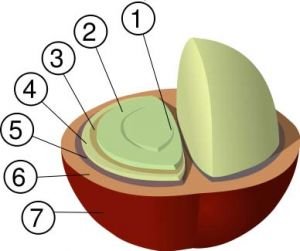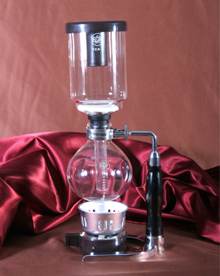Knowledge of siphon pot brewing coffee: detailed explanation of the principle and operation process of siphon pot brewing coffee
Siphon pot, also known as plug-wind pot, is a common tool for individuals and characteristic cafes to make coffee. It has a history of more than 200 years. It needs to master the thickness of coffee powder, heat and the time of coffee extraction, so it belongs to a professional coffee vessel. Because of its special shape and working principle, this device is jokingly called a chemical instrument by many people, and the process of making coffee is regarded as a chemical experiment. Let's take a look at the working principle, structure and usage of this coffee vessel.
I. the main city components of the siphon pot
1. Upper cup (for coffee powder and coffee mixing and extraction)
2. Lower cup (for filling water and coffee extract)
3. Lower cup bracket
4. Upper cup lid
5. Filter cloth (filter)
6. Alcohol lamp (heating)
7. Alcohol lamp shield
8. Coffee powder spoon / stirring bar

Second, the working principle of siphon pot
The main principle of coffee extraction in the siphon pot is realized through the pressure difference. First, the lower cup is heated to boiling, and then inserted into the upper cup, making the lower cup vacuum. Due to the pressure difference between the lower cup and the upper cup, the hot water is mixed with the upper cup coffee powder and extracted. After the extraction process, the fire source of the lower cup is removed, so that the pressure difference between the lower cup and the upper cup is instantly reduced. The gravity force between the upper cup and the lower cup will cause the coffee extract to return to the lower cup. If you want to speed up the reflux of the coffee extract, you can wipe the lower cup with a wet dishcloth, which can make the coffee extract return faster with a smaller pressure difference between the upper cup and the lower cup.
Third, the dosage standard of siphon kettle
1. The standard of adding water to the lower cup of the siphon pot: generally, there are 2, 3 and 5 people in the siphon pot, in which 2 people represent 2 cups, each cup is 120ml, its maximum capacity is 240 ml, 3 people represent 3 cups, each cup standard is 120ml, its maximum capacity is 360 ml, 5 people represents 5 cups, each cup standard is 120ml, the maximum capacity is 600ml. The scale on the siphon pot represents the capacity, indicating a few degrees, then the water capacity of the siphon pot is Nylon 120m; take the 3-cup siphon pot as shown in the following figure

2. Standard of coffee powder consumption in siphon pot: generally, the amount of coffee powder needed to brew a cup of coffee in a siphon pot (120ml/ cup) is about 15g. The coffee powder spoon corresponding to the siphon pot is usually 10g/ spoon, that is, one and a half tablespoons of coffee powder is needed for a cup of coffee. To make a few cups of coffee, just add it according to the corresponding amount of powder. For example, when making two cups of coffee, you usually add 3 tablespoons of coffee powder, that is, 30g coffee powder, and the scale spoon is shown below:

3. To sum up: it takes 15 g coffee powder to make one cup of coffee, 15 g coffee powder to make one cup of coffee, and 30 g coffee powder to brew two cups of coffee. Of course, you can increase or decrease the amount of coffee powder per cup according to your taste, which generally fluctuates between 10 and 20 g.
IV. How to use the siphon pot
1. Grind coffee beans into coffee powder (if you are preparing coffee powder, omit this step)
Grind the coffee beans into coffee powder; according to the number of coffee cups to be boiled, determine how many beans to grind, and recommend how much to drink, how much to grind, how much to cook. It takes about 15g of coffee powder to brew a cup of coffee. To make a few cups of coffee, grind the corresponding amount of coffee beans.

2. Take out the upper cup of the siphon pot, fix the filter cloth on the upper cup, and hang the fixing retractor on the glass pipe wall at the bottom of the upper cup, as shown in the following figure:

3. Add pure water or hot water to the lower cup of the siphon pot according to the number of cups to be brewed, and pay attention to adding water to the corresponding scale, as shown in the following figure:

4. Add coffee powder to the top cup of the siphon pot, and add the corresponding coffee powder standard according to the number of cups to be cooked (refer to the siphon pot coffee powder dosage standard), as shown in the following figure:

5. Insert the upper cup into the lower cup and lean against the lower cup, as shown in the following figure:

6. Light the alcohol lamp and heat the siphon pot until the next cup of water boils and starts to bubble, as shown in the following picture.

7. when the water is completely boiling, straighten the upper cup and insert the upper cup vertically into the lower cup so that there is a seamless connection between the upper cup and the lower cup. Due to the warm pressure and air pressure of the lower cup, the hot water of the lower cup goes up until more than 95% of the water enters the upper cup (there will always be some water residue in the lower cup of the siphon pot), keeping the heating state of the alcohol lamp unchanged. At this time, the heating center of the alcohol lamp can be appropriately adjusted to deviate slightly from the bottom of the lower cup of the siphon pot (mainly to prevent excessive heating, resulting in the bursting of the cup body due to the lack of water in the lower cup of the siphon pot), as shown in the following figure:

8. Coffee liquid extraction: the whole cycle of coffee liquid is less than 1 minute from the beginning of mixing to the completion of extraction; first of all, when the lower cup of water more than 1 prime 3 enters the upper cup, the firepower can be slightly removed to reduce firepower, and then the coffee powder is stirred clockwise from the outside to the middle for 10 seconds to ensure that all coffee powder is immersed in water. Then start the clock, after 40 seconds (this process is usually called stuffy steaming), re-use the stirring stick to start stirring the coffee liquid counterclockwise for 5 seconds, then quickly remove the alcohol lamp and put out the fire. The coffee liquid begins to flow back from the upper cup to the lower cup. In the process of coffee liquid reflux, if you wipe the lower cup of the siphon pot with a wet dishcloth, it can speed up the cooling of the lower cup, reduce the temperature and pressure of the lower cup, and accelerate the reflux rate of the coffee liquid from the upper cup to the lower cup. (note: in the course of using the siphon pot, there are some different sounds, that is, when to put the coffee powder is more reasonable, generally speaking, put the coffee powder first and lean the upper cup of the siphon pot against the lower cup and wait for the water to boil and straighten the upper cup, that is, the method described in this paper is not very different from the water mixing from the lower cup to the upper cup and then adding powder to the upper cup. The steaming time of the latter method can be increased from 40 seconds described in the appeal to 45 seconds)

9. The brewed coffee is shown in the picture:

10. Sugar or milk can be added according to your taste

5. Simple cleaning of siphon pot
1. Hold the glass tube in the upper seat with your hand and gently pat the mouth of the bottle with the palm of your left hand.
2. Then, tap three more times around the glass to make the coffee powder loose.
3. After the coffee powder is poured out, rinse the inner edge of the cup with clean water and rinse gently around.
4. Rinse the filter directly with clean water to remove the dregs.
5. Remove the filter spring hook and rinse thoroughly with clean water.
6. Use both hands to pick up, squeeze, circle and wring dry (when not in use, please put the filter / cloth ice in water to avoid oxidation)
7. Touch the detergent with the cup brush, scrub the upper seat, be careful of the bottle mouth breaking, the glass tube hitting the sink or cup, etc.
Source: Douban net
Important Notice :
前街咖啡 FrontStreet Coffee has moved to new addredd:
FrontStreet Coffee Address: 315,Donghua East Road,GuangZhou
Tel:020 38364473
- Prev

From the composition and composition of coffee beans to talk about the acidity of coffee to understand the structural growth substances of coffee beans
Caffeic acid [Chinese name] caffeic acid [English name] Caffeic acid [composition classification] Organic acids and phenolic coffee acidity may be the most incorrect and most misunderstood term used to evaluate the taste of coffee. This is a quantitative term that refers to the relative strength of the acidic components in the liquid being evaluated. Although the terms of coffee are sour and descriptive
- Next

The principle of operation of the siphon pot: illustrate how to use the siphon pot to make coffee is caused by the chemical principle.
Drinking coffee is a kind of enjoyment and an indispensable element in modern life. Her acidity, bitterness and fragrance deeply infect everyone who loves coffee, whether they are senior coffee enthusiasts or beginners of coffee. Making a cup of coffee with strong flavor every day is as natural as brushing your teeth and washing your face. It is generally believed that drinking coffee is a kind of enjoyment, and in addition to enjoyment, more people
Related
- What is the meaning of lactic acid fermentation with coffee bean treatment?
- How to judge the state of foam by sound?
- How does the latte pull out the unicorn pattern? Come to get for a little trick to improve the flower pull!
- Will flower pulling affect the taste of the latte?
- Do you know the history of coffee?
- The difference between honey treatment and sun washing what is raisin honey treatment?
- What kind of milk can a novice use to make coffee foam to keep the foam longer? The correct method and skills of milking tutorial sharing
- Why do washed coffee beans taste sour? Flavor characteristics of washed Coffee
- Introduction to the skill of how to practice the size and height of water injection around the circle of hand-brewed coffee
- How do beginners practice coffee flower drawing from scratch?

